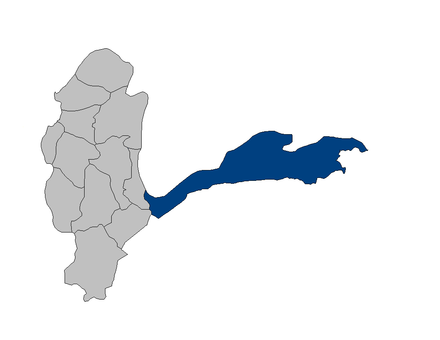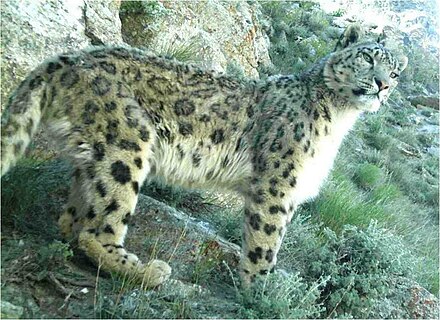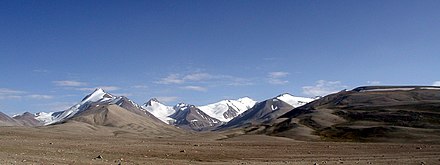Wakhan Corridor - region in Badakhshan province in northeastern Afghanistan

The corridor is the most direct route between Afghanistan and China, and a minor trade route. However, it has never become a major route because the terrain is quite difficult and at times the hill tribes can be as well. The main routes from Afghanistan to China start by going either north over the Salang Pass to Bactria or east through the Khyber Pass into central Pakistan.
The corridor is an artifact created by the Great Game, the intense competition between the British and Russian empires for influence in the region during the latter part of the 19th century. Its northern border was originally between Afghanistan and the Russian Empire (now between Afghanistan and Tajikistan) and was defined in an Anglo-Russian treaty. The southern border was established between Afghanistan and the Raj (now between Afghanistan and Pakistan), and defined in an Anglo-Afghan treaty. The main reason for creating the corridor was that the British wanted to avoid having a direct border between the two empires.
The entire district has been designated Wakhan National Park. This is mainly a wildlife preserve; among the rare species found here are snow leopards and several types of wild sheep and goats.
Understand
 The latitude is about 37 °N (roughly that of Washington, Lisbon, or Seoul) but the whole area is at high altitude — Lake Zorkul is above 4,000 m or 13,000 feet — and there are no large bodies of water anywhere nearby, so winters are quite severe.
The latitude is about 37 °N (roughly that of Washington, Lisbon, or Seoul) but the whole area is at high altitude — Lake Zorkul is above 4,000 m or 13,000 feet — and there are no large bodies of water anywhere nearby, so winters are quite severe.
26 km long Lake Zorkul, the source of the Pamir river which is a tributary of the Amu Darya (known in ancient times as the Oxus) is the only significant body of water and provides fantastic ice-skating in winter if you can survive the altitude and cold. You may be able to shelter in the minute settlement of Qarabolaq at the eastern end of the lake. The lake's northern half lies in Tajikistan where it is protected as part of the Zorkul Nature Reserve.
Talk
There is a local language called Wakhi, spoken mainly in the corridor but also in some nearby areas. Persian, either the Tajik dialect or the Dari variant of Afghanistan, is also common.
Get in
While both China and Pakistan border this area, there are no legal border crossings, and you stand a good chance of ending up in prison. It is possible to enter the corridor from Afghanistan, in particular from Bactria in the north, but that is very dangerous. The only way in and out that is legal and might be relatively safe is crossing the Oxus from the north, via Ishkashim, Tajikistan.
There has been word of a possible new border crossing between Afghanistan and Pakistan at the Broghil Pass. There are no checkpoints, but, if you're willing to do a lot of legwork to get the necessary and arduous permissions, start your enquiry in Kabul.
The adventure travel company Secret Compass have arranged expeditions to the Wakhan, usually in the summertime, but as of early 2023 they have none scheduled.
Get around
You can hire a Jeep. A jeep from Eshkashim to Sarhad-e-Wakhan (8-hour trip) cost US$400 in June 2011; to Sarhad-e-Broghil, the price would have been US$200. Getting back down from the valley can be difficult if you haven't arranged for a pick-up, as traffic is very scarce.
There is no modern road through the "Corridor" which has not been an official transit route from China for more than 100 years. There's a rough road from E/Ishkashim to Sarhad-e Broghil that was finished in 1968 but only yak tracks and sheep paths beyond. It's more than 100 km from where this road finishes to Chinese territory at Wakhjir Pass and further still to the far end of the Little Pamir.
See
- Concord Peak 5,469 m (17,943 ft) straddles the border between Tajikistan and Afghanistan. On the Afghan side is a tiny settlement of the same name (also known as Qareh Būlāq). It was from there that the people of Qarabolaq in Tajikistan moved at the end of the 19th century before the border with what was then Czarist Russia was delineated.
- Lake Zorkul is azure blue. Ole Olufsen, leader of a Danish expedition in 1888-9, wrote in his journals that local people said the lake had loads of sea-horses that "come out of the water to graze and then pair with the horses in the fields, and this crossing is said to be very good for the breed. To venture out on these lakes is death, as the sea-monsters would immediately pull one down into the deep."

Do
Trekking is the main reason you would come to this region.
If you want to do wildlife photography here, you will certainly need a telephoto lens and you may need an extremely long one for shots where the beast is across a valley.
Buy
Eat
Drink
Sleep
Lodging
Camping
Stay safe
This is a rural and undeveloped region. Visiting should not be attempted without good skills, good equipment and trustworthy local guides.
The entire country is an extremely high-risk area where travel is strongly discouraged; see Afghanistan#Stay_safe. The corridor is isolated enough that some risks may be lower but others — such as local banditry and a lack of police or other government presence — are quite likely higher.
Altitude sickness is also a serious risk. Most of the region is above 3000 m (10,000 feet) and some parts are considerably higher.
Go next
Wakhan Corridor
Timezone:MultiplePopulation:12,000Coordinates:37.00, 73.00